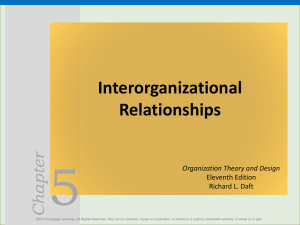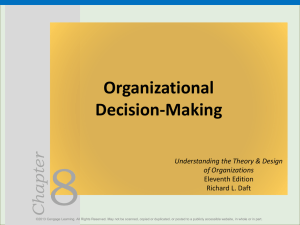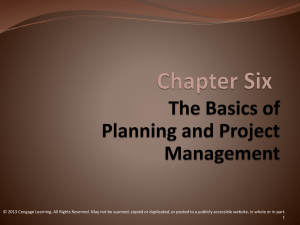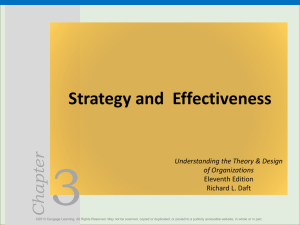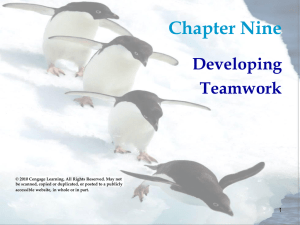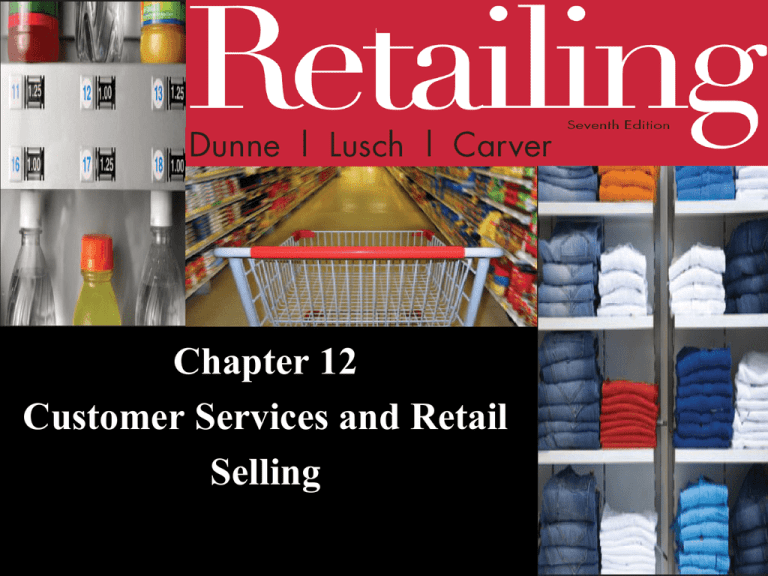
Chapter 12
Customer Services and Retail
Selling
Customer Service
High-quality service - A service that meets or
exceeds customers’ expectations.
A way in which retailers provide the high-quality
service expected and reduce customer defections
is through relationship retailing programs.
Relationship retailing programs - The activities
designed to attract, retain, and enhance long-term
relationships with customers.
© 2011 Cengage Learning. All Rights Reserved. May not be scanned, copied or duplicated, or posted to a publicly accessible website, in whole or in part.
LO 1
Customer Service
Retailers can develop long-term relationships with
their customers by offering:
financial benefits
social benefits
© 2011 Cengage Learning. All Rights Reserved. May not be scanned, copied or duplicated, or posted to a publicly accessible website, in whole or in part.
LO 1
Exhibit 12.3 - Three Basic Tasks of Retailing
© 2011 Cengage Learning. All Rights Reserved. May not be scanned, copied or duplicated, or posted to a publicly accessible website, in whole or in part.
LO 1
Customer Service
It consists of all those activities performed by the
retailer that influence:
the ease with which a potential customer can shop or
learn about the store’s offering.
the ease with which a transaction can be completed
once the customer attempts to make a purchase.
the customer’s satisfaction with the transaction.
© 2011 Cengage Learning. All Rights Reserved. May not be scanned, copied or duplicated, or posted to a publicly accessible website, in whole or in part.
LO 1
Customer Service stopped
Transient customer - An individual who is
dissatisfied with the level of customer service
offered at a store or stores and is seeking an
alternative store with the level of customer service
that he or she thinks is appropriate.
Gives another store the opportunity to convert
them
What are some of the stores you know which actively
work to avoid losing customers – and how do they do it?
© 2011 Cengage Learning. All Rights Reserved. May not be scanned, copied or duplicated, or posted to a publicly accessible website, in whole or in part.
LO 1
Customer Service
It must be integrated into all the following aspects
of retailing:
Merchandise management
Building and fixture management
Promotion management
Price management
Credit management
Examples of good and bad?
© 2011 Cengage Learning. All Rights Reserved. May not be scanned, copied or duplicated, or posted to a publicly accessible website, in whole or in part.
LO 1
Common Customer Services
Pretransaction services - Provided to the
customer prior to entering the store.
Convenient hours – Examples of those which don’t?
Information aids – such as?
See p. 442
© 2011 Cengage Learning. All Rights Reserved. May not be scanned, copied or duplicated, or posted to a publicly accessible website, in whole or in part.
LO 2
Common Customer Services
Transaction services - Provided to customers
when they are in the store shopping and
transacting business.
Credit
Layaway
Gift wrapping and
packaging
Check cashing
Gift cards
Personal shopping
Merchandise availability
Personal selling
Sales transaction
© 2011 Cengage Learning. All Rights Reserved. May not be scanned, copied or duplicated, or posted to a publicly accessible website, in whole or in part.
LO 2
Common Customer Services
Personal shopping - An individual who is a
professional shopper performs the shopping role
for another; very upscale department and specialty
stores offer personal shoppers to their clients.
Dwell time - The amount of time a consumer
must spend waiting to complete a purchase. Want
to minimize this.
See pp. 448
© 2011 Cengage Learning. All Rights Reserved. May not be scanned, copied or duplicated, or posted to a publicly accessible website, in whole or in part.
LO 2
Common Customer Services
Posttransaction services - Provided to customers
after they have purchased merchandise or
services.
Complaint handling
Accepting Merchandise
returns
Be careful of fraudulent returns
Renting, not buying
Fraudulent employee actions
Shoplift returns
Price switching (harder now)
Servicing, repair, and
warranties
Delivery
Postsale follow-up
© 2011 Cengage Learning. All Rights Reserved. May not be scanned, copied or duplicated, or posted to a publicly accessible website, in whole or in part.
LO 2
Exhibit 12.4 - Six Rules to Follow When Handling a
Customer’s Complaint
© 2011 Cengage Learning. All Rights Reserved. May not be scanned, copied or duplicated, or posted to a publicly accessible website, in whole or in part.
LO 2
Exhibit 12.5 - Factors to Consider When
Determining Customer Services to Offer
© 2011 Cengage Learning. All Rights Reserved. May not be scanned, copied or duplicated, or posted to a publicly accessible website, in whole or in part.
LO 3
Exhibit 12.6 How the Retailer’s Sales Force Meets
the Expectations of Both Vendors and Customers
© 2011 Cengage Learning. All Rights Reserved. May not be scanned, copied or duplicated, or posted to a publicly accessible website, in whole or in part.
LO 3
Retail Sales Management
Types of retail selling
Salesperson selection
Salesperson training
Evaluation of salespeople
© 2011 Cengage Learning. All Rights Reserved. May not be scanned, copied or duplicated, or posted to a publicly accessible website, in whole or in part.
LO 4
Retail Sales Management
Types of retail selling
Retailers that concentrate on the sale of shopping
goods want their salespeople to both get and take
orders.
In lines of retail trade where predominantly
convenience goods are sold, the role of the salesperson
is that of an order taker.
It is generally true that retailers with high margins and
high levels of customer service place more emphasis
on order getting; those with low margins and a low
customer service policy tend to emphasize order
taking.
© 2011 Cengage Learning. All Rights Reserved. May not be scanned, copied or duplicated, or posted to a publicly accessible website, in whole or in part.
LO 4
Retail Sales Management
Salesperson selection
Hiring criteria
Predictors
Demographics
Personality
Knowledge and intelligence
Experience
© 2011 Cengage Learning. All Rights Reserved. May not be scanned, copied or duplicated, or posted to a publicly accessible website, in whole or in part.
LO 4
Retail Sales Management
Salesperson training
Retailer’s policies
Merchandise
Customer types
Customer choice criteria
No active product choice criteria
Inadequate or vague choice criteria
Choice criteria in conflict
Explicit choice criteria
© 2011 Cengage Learning. All Rights Reserved. May not be scanned, copied or duplicated, or posted to a publicly accessible website, in whole or in part.
LO 4
Exhibit 12.7 - Various Customer Types
© 2011 Cengage Learning. All Rights Reserved. May not be scanned, copied or duplicated, or posted to a publicly accessible website, in whole or in part.
LO 4
Exhibit 12.7 - Various Customer Types
© 2011 Cengage Learning. All Rights Reserved. May not be scanned, copied or duplicated, or posted to a publicly accessible website, in whole or in part.
LO 4
Retail Sales Management
Evaluation of salespeople
Performance standards
Conversion rate
Sales per hour
Use of time
Selling time
Nonselling time
Idle time
Absent time
Data requirements
© 2011 Cengage Learning. All Rights Reserved. May not be scanned, copied or duplicated, or posted to a publicly accessible website, in whole or in part.
LO 4
Retail Sales Management
Conversion rate - Percentage of shoppers that
enter the store that are converted into purchasers.
Sales per hour is computed by dividing total
dollar sales over a particular time frame by total
salesperson or sales-force hours.
© 2011 Cengage Learning. All Rights Reserved. May not be scanned, copied or duplicated, or posted to a publicly accessible website, in whole or in part.
LO 4
Exhibit 12.8 - Selling Process in the Retail
Environment
© 2011 Cengage Learning. All Rights Reserved. May not be scanned, copied or duplicated, or posted to a publicly accessible website, in whole or in part.
LO 5
Exhibit 12.8 - Selling Process in the Retail
Environment
© 2011 Cengage Learning. All Rights Reserved. May not be scanned, copied or duplicated, or posted to a publicly accessible website, in whole or in part.
LO 5
Exhibit 12.8 - Selling Process in the Retail
Environment
© 2011 Cengage Learning. All Rights Reserved. May not be scanned, copied or duplicated, or posted to a publicly accessible website, in whole or in part.
LO 5
Exhibit 12.9 - Some Closing Signals the
Salespeople Should Watch For
© 2011 Cengage Learning. All Rights Reserved. May not be scanned, copied or duplicated, or posted to a publicly accessible website, in whole or in part.
LO 5
The Retail Sales Process
Prospecting - Locating or identifying potential
customers who have the ability and willingness to
purchase your product.
Closing the sale - Action the salesperson takes to
bring a potential sale to its natural conclusion.
© 2011 Cengage Learning. All Rights Reserved. May not be scanned, copied or duplicated, or posted to a publicly accessible website, in whole or in part.
LO 5
The Customer-Service and SalesEnhancement Audit
The objectives of the audit
Identify the service, salesmanship, and salesenhancement methods that will produce more sales
from the existing shopping traffic.
Target the methods by store and selling area that will
produce the most significant improvements.
Determine the added sales that can be generated by
improving the accepted service level, salesmanship,
and sales-enhancement programs.
© 2011 Cengage Learning. All Rights Reserved. May not be scanned, copied or duplicated, or posted to a publicly accessible website, in whole or in part.
LO 6
The Customer-Service and SalesEnhancement Audit
Advantages of the audit:
Provides management with a detailed analysis of
current sales activity by location and by selling area.
Identifies how and where additional sales volume is
available.
Measures, analyzes, and reports on the specific factors.
© 2011 Cengage Learning. All Rights Reserved. May not be scanned, copied or duplicated, or posted to a publicly accessible website, in whole or in part.
LO 6
The Customer-Service and SalesEnhancement Audit
Basic service
Customer contact
Salesperson-initiated contact
Customer acknowledgment
Salesmanship
Merchandise knowledge
Needs clarification
Active selling
Suggestion selling
© 2011 Cengage Learning. All Rights Reserved. May not be scanned, copied or duplicated, or posted to a publicly accessible website, in whole or in part.
LO 6
The Customer-Service and SalesEnhancement Audit
Sales enhancement
Impulse purchasing
Walkouts
© 2011 Cengage Learning. All Rights Reserved. May not be scanned, copied or duplicated, or posted to a publicly accessible website, in whole or in part.
LO 6


